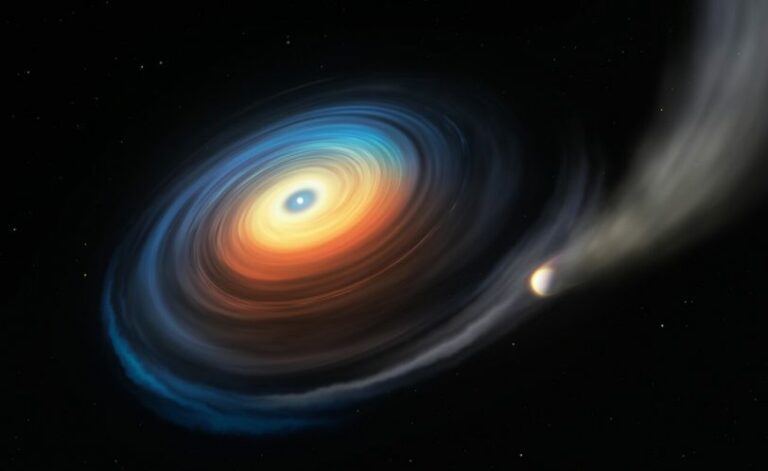For the First Time, Astronomers Have Discovered a Giant Planet Orbiting a Tiny White Dwarf Star
Astronomers have made a groundbreaking discovery of a massive planet orbiting a small, lifeless white dwarf star for the first time. What is even more surprising is that this Neptune-sized planet is more than four times larger than the star it orbits, which is comparable in size to Earth. The study’s lead author, Boris Gänsicke from the University of Warwick, explained that the planet is not visible to us directly, but its presence is detected by the star’s high temperature, causing the planet’s atmosphere to evaporate. This process creates a stream of vaporized material emanating from the planet, estimated to be around 260 million tons per day.
This finding provides evidence that a large planet can survive a star’s evolution into a white dwarf and suggests that evaporating planets orbiting around dead stars are prevalent in the universe. It could also provide insights into the ultimate fate of our solar system, as our Sun is predicted to transform into a white dwarf in the future.
An unexpected pairing
Located in the constellation Cancer and situated around 1,500 light-years away, the white dwarf, WDJ0914+1914, is still scorching hot despite no longer undergoing nuclear fusion like a normal star. With a temperature of 49,500 degrees Fahrenheit, it’s about five times hotter than the Sun. The discovery of this smoldering stellar core came after researchers sifted through approximately 7,000 white dwarfs identified by the Sloan Digital Sky Survey. Upon observing the unique spectra of WDJ0914+1914, they noticed hydrogen chemical fingerprints, which is somewhat unusual, and elements such as oxygen and sulfur, which they had never seen in a white dwarf before.
The team, curious about what was occurring in the unusual system, used the X-shooter instrument on the European Southern Observatory’s Very Large Telescope in Chile to conduct further observations. They discovered that the uncommon elements they initially believed were present in the white dwarf were actually emanating from a disk of gas that was churning around the dead star.
According to Boris Gänsicke, the first assumption was that the white dwarf, WDJ0914+1914, was a binary star with a disk of gas formed by mass transfer between the two stars. However, after conducting follow-up observations using the ESO’s Very Large Telescope, the researchers found out that it was a single white dwarf surrounded by a disk approximately ten times larger than our Sun, made up of hydrogen, oxygen, and sulfur. The team soon realized that the only explanation for such a unique system was the evaporation of a giant planet, which took them a few weeks to figure out. Matthias Schreiber, an astronomer from the University of Valparaiso in Chile, played a crucial role in determining the past and future evolution of the extraordinary system.
According to their analysis, the composition of the disk around the white dwarf matched what astronomers would expect if the interiors of ice giants like Uranus and Neptune were vaporized into space.
The extreme heat of the white dwarf causes it to bombard the nearby giant planet with high-energy photons, resulting in the planet losing mass at a rate exceeding 3,000 tons per second. However, the researchers note in their paper, published in the journal Nature, that as the white dwarf continues to cool, the rate of mass loss will gradually decrease until it becomes undetectable in about 350 million years. By that time, the giant planet will only have lost a negligible fraction of its total mass, or about 0.04 Neptune masses.
The proximity of the giant planet to the white dwarf should have caused it to be destroyed during the stars’ red giant phase, but the fact that it survived suggests that it must have migrated inward after the star became a white dwarf.
According to Gänsicke, the discovery is a significant breakthrough because for the past 20 years, there has been increasing evidence that planetary systems can endure until the white dwarf phase. Although there have been sightings of asteroids, comets, and other small planetary objects colliding with white dwarfs, explaining these occurrences necessitates larger, planet-sized bodies located farther away. Gänsicke believes that discovering a planet that was itself scattered into the system is a critical step forward.
The ultimate fate of our solar system
In about 5 billion years, the Sun will deplete its core hydrogen and initiate fusion of concentric shells of hydrogen around its inert core. This unstable process will transform the Sun into a red giant, which will consume Mercury, Venus, and potentially Earth. As the Sun expands, its gravitational hold on its outer envelope weakens, resulting in the shedding of its outer layers into space. Once this occurs, an extraterrestrial observer would observe a stunning planetary nebula encircling the Sun’s scorched, extremely hot core, now known as a white dwarf.
“WDJ0914+1914 is, in a way, granting us a look into the very remote future of our own solar system,” Schreiber stated.
Do not forget to share your opinion with us to provide you with the best posts !




0 Comments